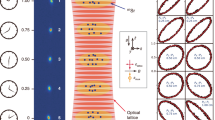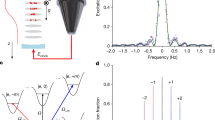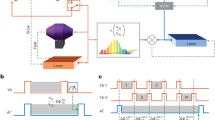Abstract
The passage of time is tracked by counting oscillations of a frequency reference, such as Earth’s revolutions or swings of a pendulum. By referencing atomic transitions, frequency (and thus time) can be measured more precisely than any other physical quantity, with the current generation of optical atomic clocks reporting fractional performance below the 10−17 level1,2,3,4,5. However, the theory of relativity prescribes that the passage of time is not absolute, but is affected by an observer’s reference frame. Consequently, clock measurements exhibit sensitivity to relative velocity, acceleration and gravity potential. Here we demonstrate local optical clock measurements that surpass the current ability to account for the gravitational distortion of space-time across the surface of Earth. In two independent ytterbium optical lattice clocks, we demonstrate unprecedented values of three fundamental benchmarks of clock performance. In units of the clock frequency, we report systematic uncertainty of 1.4 × 10−18, measurement instability of 3.2 × 10−19 and reproducibility characterized by ten blinded frequency comparisons, yielding a frequency difference of [−7 ± (5)stat ± (8)sys] × 10−19, where ‘stat’ and ‘sys’ indicate statistical and systematic uncertainty, respectively. Although sensitivity to differences in gravity potential could degrade the performance of the clocks as terrestrial standards of time, this same sensitivity can be used as a very sensitive probe of geopotential5,6,7,8,9. Near the surface of Earth, clock comparisons at the 1 × 10−18 level provide a resolution of one centimetre along the direction of gravity, so the performance of these clocks should enable geodesy beyond the state-of-the-art level. These optical clocks could further be used to explore geophysical phenomena10, detect gravitational waves11, test general relativity12 and search for dark matter13,14,15,16,17.
This is a preview of subscription content, access via your institution
Access options
Access Nature and 54 other Nature Portfolio journals
Get Nature+, our best-value online-access subscription
$32.99 / 30 days
cancel any time
Subscribe to this journal
Receive 51 print issues and online access
$199.00 per year
only $3.90 per issue
Buy this article
- Purchase on SpringerLink
- Instant access to full article PDF
Prices may be subject to local taxes which are calculated during checkout




Similar content being viewed by others
Data availability
The data that support the findings of this study are available from the corresponding author upon reasonable request.
References
Chou, C. W., Hume, D. B., Koelemeij, J. C. J., Wineland, D. J. & Rosenband, T. Frequency comparison of two high-accuracy Al+ optical clocks. Phys. Rev. Lett. 104, 070802 (2010).
Nicholson, T. L. et al. Systematic evaluation of an atomic clock at 2×10−18 total uncertainty. Nat. Commun. 6, 6896 (2015).
Huntemann, N., Sanner, C., Lipphardt, B., Tamm, C. & Peik, E. Single-ion atomic clock with 3×10−18 systematic uncertainty. Phys. Rev. Lett. 116, 063001 (2016).
Schioppo, M. et al. Ultra-stable optical clock with two cold-atom ensembles. Nat. Photon. 11, 48–52 (2017).
Takano, T. et al. Geopotential measurements with synchronously linked optical lattice clocks. Nat. Photon. 10, 662–666 (2016).
Chou, C. W., Hume, D. B., Rosenband, T. & Wineland, D. J. Optical clocks and relativity. Science 329, 1630–1633 (2010).
Delva, P. & Lodewyck, J. Atomic clocks: new prospects in metrology and geodesy. Acta Futura 7, 67–78 (2013).
Lion, G. et al. Determination of a high spatial resolution geopotential model using atomic clock comparisons. J. Geod. 91, 597–611 (2017).
Grotti, J. et al. Geodesy and metrology with a transportable optical clock. Nat. Phys. 14, 437–441 (2018).
Bondarescu, R. et al. Ground-based optical atomic clocks as a tool to monitor vertical surface motion. Geophys. J. Int. 202, 1770–1774 (2015).
Kolkowitz, S. et al. Gravitational wave detection with optical lattice atomic clocks. Phys. Rev. D 94, 124043 (2016).
Delva, P. et al. Test of special relativity using a fiber network of optical clocks. Phys. Rev. Lett. 118, 221102 (2017).
Derevianko, A. & Pospelov, M. Hunting for topological dark matter with atomic clocks. Nat. Phys. 10, 933–936 (2014).
Arvanitaki, A., Huang, J. & Van Tilburg, K. Searching for dilaton dark matter with atomic clocks. Phys. Rev. D 91, 015015 (2015).
Wcisło, P. et al. Experimental constraint on dark matter detection with optical atomic clocks. Nat. Astron. 1, 0009 (2016).
Hees, A., Guéna, J., Abgrall, M., Bize, S. & Wolf, P. Searching for an oscillating massive scalar field as a dark matter candidate using atomic hyperfine frequency comparisons. Phys. Rev. Lett. 117, 061301 (2016).
Roberts, B. M. et al. Search for domain wall dark matter with atomic clocks on board global positioning system satellites. Nat. Commun. 8, 1195 (2017).
Soffel, M. et al. The IAU 2000 resolutions for astrometry, celestial mechanics, and metrology in the relativistic framework: explanatory supplement. Astron. J. 126, 2687–2706 (2003).
Vanicek, P., Castle, R. O. & Balazs, E. I. Geodetic leveling and its applications. Rev. Geophys. 18, 505–524 (1980).
Wang, Y. M., Saleh, J., Li, X. & Roman, D. R. The US Gravimetric Geoid of 2009 (USGG2009): model development and evaluation. J. Geod. 86, 165–180 (2012).
Denker, H. et al. Geodetic methods to determine the relativistic redshift at the level of 10−18 in the context of international timescales: a review and practical results. J. Geod. 92, 487–516 (2018).
Beloy, K. et al. Atomic clock with 1 × 10−18 room-temperature blackbody Stark uncertainty. Phys. Rev. Lett. 113, 260801 (2014).
Beloy, K. et al. Faraday-shielded dc Stark-shift-free optical lattice clock. Phys. Rev. Lett. 120, 183201 (2018).
Brown, R. C. et al. Hyperpolarizability and operational magic wavelength in an optical lattice clock. Phys. Rev. Lett. 119, 253001 (2017).
Ushijima, I., Takamoto, M., Das, M., Ohkubo, T. & Katori, H. Cryogenic optical lattice clocks. Nat. Photon. 9, 185–189 (2015).
Akatsuka, T., Takamoto, M. & Katori, K. Optical lattice clocks with non-interacting bosons and fermions. Nat. Phys. 4, 954–959 (2008).
Campbell, S. L. et al. A Fermi-degenerate three-dimensional optical lattice clock. Science 358, 90–94 (2017).
Gibble, K. Scattering of cold-atom coherences by hot atoms: frequency shifts from background-gas collisions. Phys. Rev. Lett. 110, 180802 (2013).
Lemke, N. D. et al. Spin-1/2 optical lattice clock. Phys. Rev. Lett. 103, 063001 (2009).
Zhang, X. et al. Spectroscopic observation of SU(N)-symmetric interactions in Sr orbital magnetism. Science 345, 1467–1473 (2014).
Pavlis, N. K. & Weiss, M. A. A re-evaluation of the relativistic redshift on frequency standards at NIST, Boulder, Colorado, USA. Metrologia 54, 535–548 (2017).
Bruinsma, S. L. et al. ESA’s satellite-only gravity field model via the direct approach based on all GOCE data. Geophys. Res. Lett. 41, 7508–7514 (2014).
Smith, D. The GRAV-D Project: Gravity for the Redefinition of the American Vertical Datum https://www.ngs.noaa.gov/GRAV-D/pubs/GRAV-D_v2007_12_19.pdf (NOAA, 2007).
Curtis, E. A., Oates, C. W. & Hollberg, L. Quenched narrow-line second- and third-stage laser cooling of 40Ca. J. Opt. Soc. Am. B 20, 977–984 (2003).
Nemitz, N. et al. Frequency ratio of Yb and Sr clocks with 5×10−17 uncertainty at 150 seconds averaging time. Nat. Photon. 10, 258–261 (2016).
Lemke, N. D. et al. p-wave cold collisions in an optical lattice clock. Phys. Rev. Lett. 107, 103902 (2011).
Julienne, P. S. & Mies, F. H. Collisions of ultracold trapped atoms. J. Opt. Soc. Am. B 6, 2257–2269 (1989).
Dzuba, V. A. & Derevianko, A. Dynamic polarizabilities and related properties of clock states of the ytterbium atom. J. Phys. B 43, 074011 (2010).
Swallows, M. D. et al. Suppression of collisional shifts in a strongly interacting lattice clock. Science 331, 1043–1046 (2011).
Katori, H., Takamoto, M., Pal’chikov, V. G. & Ovsiannikov, V. D. Ultrastable optical clock with neutral atoms in an engineered light shift trap. Phys. Rev. Lett. 91, 173005 (2003).
Ma, L., Jungner, P., Ye, J. & Hall, J. L. Delivering the same optical frequency at two places: accurate cancellation of phase noise introduced by an optical fiber or other time-varying path. Opt. Lett. 19, 1777–1779 (1994).
Falke, S., Misera, M., Sterr, U. & Lisdat, C. Delivering pulsed and phase stable light to atoms of an optical clock. Appl. Phys. B 107, 301–311 (2012).
Porsev, S. G. & Derevianko, A. Multipolar theory of blackbody radiation shift of atomic energy levels and its implications for optical lattice clocks. Phys. Rev. A 74, 020502 (2006).
Katori, H., Ovsiannikov, V. D., Marmo, S. I. & Palchikov, V. G. Strategies for reducing the light shift in atomic clocks. Phys. Rev. A 91, 052503 (2015).
Boyd, M. et al. Nuclear spin effects in optical lattice clocks. Phys. Rev. A 76, 022510 (2007).
Lodewyck, J., Zawada, M., Lorini, L., Gurov, M. & Lemonde, P. Observation and cancellation of a perturbing dc Stark shift in strontium optical lattice clocks. IEEE Trans. Ultrason. Ferroelectr. Freq. Control 59, 411–415 (2012).
Lemonde, P. & Wolf, P. Optical lattice clock with atoms confined in a shallow trap. Phys. Rev. A 72, 033409 (2005).
Lee, W. D., Shirley, J. H., Walls, F. L. & Drullinger, R. E. Systematic errors in cesium beam frequency standards introduced by digital control of the microwave excitation. Proc. IEEE Int. Freq. Control Symp. Expo. 113–117 (1995).
Hofmann-Wellenhof, B. & Moritz, H. Physical Geodesy (Springer, Vienna, 2005).
Bize, S. et al. Interrogation oscillator noise rejection in the comparison of atomic fountains. IEEE Trans. Ultrason. Ferroelectr. Freq. Control 47, 1253–1255 (2000).
Takamoto, M., Takano, T. & Katori, H. Frequency comparison of optical lattice clocks beyond the Dick limit. Nat. Photon. 5, 288–292 (2011).
Acknowledgements
We acknowledge financial support from the National Institute of Standards and Technology, the NASA Fundamental Physics programme, the Defense Advanced Research Projects Agency (DARPA) Quantum Assisted Sensing and Readout (QuASAR) programme and PECASE. R.C.B. acknowledges support from the National Research Council Research Associateship programme. A.D.L. acknowledges support from the International Space Science Institute for contributions to the Spacetime Metrology, Clocks and Relativistic Geodesy Workshop. We also thank T. Fortier and H. Leopardi for femtosecond optical frequency comb measurements, and J. Kitching and D. Hume for careful reading of this manuscript.
Reviewer information
Nature thanks K. Bongs, P. Delva and T. Ido for their contribution to the peer review of this work.
Author information
Authors and Affiliations
Contributions
W.F.M., X.Z., R.J.F., S.A.S., D.N. and A.D.L. carried out the instability and reproducibility measurements. W.F.M., X.Z., S.A.S., K.B., D.N., R.C.B., N.H., G.M., M.S., T.H.Y. and A.D.L. contributed to the evaluation of the uncertainty budget. A.D.L. supervised this work. All authors contributed to the final manuscript. Contributions to this article by workers at NIST, an agency of the US Government, are not subject to US copyright.
Corresponding author
Ethics declarations
Competing interests
The authors declare no competing interests.
Additional information
Publisher’s note: Springer Nature remains neutral with regard to jurisdictional claims in published maps and institutional affiliations.
Rights and permissions
About this article
Cite this article
McGrew, W.F., Zhang, X., Fasano, R.J. et al. Atomic clock performance enabling geodesy below the centimetre level. Nature 564, 87–90 (2018). https://doi.org/10.1038/s41586-018-0738-2
Received:
Accepted:
Published:
Issue date:
DOI: https://doi.org/10.1038/s41586-018-0738-2
Keywords
This article is cited by
-
An improved carrier-phase-based method for precise time synchronization using the observations from the China Space Station-ground synchronization system
Satellite Navigation (2025)
-
Integrating quantum synchronization in future generation networks
Scientific Reports (2025)
-
Optical atomic clock interrogation using an integrated spiral cavity laser
Nature Photonics (2025)
-
Demonstration of a mobile optical clock ensemble at sea
Nature Communications (2025)
-
Hamiltonian engineering of collective XYZ spin models in an optical cavity
Nature Physics (2025)




Xinhang Shen
Please be aware that Einstein's relativity is completely wrong and has been disproved for more than three years! There is no such thing called spacetime in nature. Here is a simple reasoning to disprove relativity:
In the framework of special relativity, the status of each physical process is determined by the product of relativistic time and its developing rate in each inertial reference frame such as the height of a tree which is the product of relativistic time and its growth rate. After Lorentz Transformation, relativistic time will expand by factor gamma and the developing rate will shrink by the same factor gamma (similar to the transverse Doppler-effect) to make the status i.e. the product of relativistic time and the developing rate unchanged. That is, the status of any physical process will be the same observed in all inertial reference frames. There is no dilation at all.
As the display of each physical clock is always represented by the status of a physical process such as the digital display of an atomic clock which is the product of relativistic time and its frequency divided by a calibration constant, according to the above conclusion, the display of each physical clock will be the same observed from all inertial reference frames. If there are many stationary and moving clocks have the same display observed in one inertial reference frame, then, they will have the same display observed in all inertial reference frames. This has been demonstrated by the universal synchronization of the atomic clocks on the ground and GPS satellites. That is, the physical time is absolute, but relativistic time is not the physical time we measure with physical clocks, and thus special relativity is wrong.
The fatal mistake Einstein and other relativists have made is that they wrongly have assumed that the frequency f of a clock be a frame independent constant which can be calibrated away by setting the calibration constant k = f in the reading of the clock T = tf/k = t, but in special relativity, frequency f is not frame independent. Therefore, the time of special relativity (i.e. relativistic time) is never the physical time measured with physical clocks.
For more details in disproving special relativity, please check the peer-reviewed papers:
https://www.researchgate.ne...
https://www.researchgate.ne...
If you don't agree with me, please feel free to refute my points and I will be happy to debate with you.
urho rauhala Replied to Xinhang Shen
The flaw of special relativity was extended to the physics foundations of General Relativity (GR) and Quantum Mechanics (QM) in Dr. Suntola's concept of Dynamic Universe since 1995. The absolute physical time as measured by atomic clocks has fooled the GR/QM community with the APPARENT constancy of speed of light C in local frames. DU expansion of spacetime with the 4th metric dimension R4 radius of closed Riemann 4-sphere allows tying C with the expansion speed C4 of R4 in nested energy frames based on the balance of motion and gravitational energies of the total mass M in closed 3-D space as the surface of the contracting or expanding 4-sphere. QM foundation of Planck energy constant is a function of the variable C=C4 fooling e.g. the brightness model and cosmic distance concepts needed in SN1a modeling.
My extended estimation theory of loop inverse and array calculus in surveying math sciences (developed since 1960's) can explain the compensation or 'epicycle' effect where the auxiliary biased Dark Energy and DM parameters of Einstein's mistaken 'cosmological constant' fooled about 'DE confirmation', given even 2011 Nobel although DU model fit data better without DE/DM parameters. Similar conceptual mistakes based on GR/QM flaws appear confusing also the 'proofs' of Gravitational Waves (given 2017 Nobel). I hope the cosmic truth gets heard this Christmas without further posts from three wise men. Santa Claus comes from Finland (and Amazon) for physics community in the form of books by Suntola Dynamic Universe...
Nadya
Dear Friends
we"d like to refer our "old" paper
Possibility of establishment of a quantum frequency standard for the visible range using an intercombination spectral transition in the ytterbium atom
N V Goldovskaya, V L Goldovskiĭ, Lyudvik L Shimon and I I Dudich
Sov. J. Quantum Electron. 12(12), Dec. 1982 0049-1748/82/121659-01 $04.10 © 1983 American Institute of Physics, p. 1659
In this article we made a comparative analysis of the characteristics of the n1S0 – n3Pn intercombination transition in the ytterbium atom with the characteristics of the corresponding transitions in alkaline earth atoms: magnesium, calcium, and strontium. It is suggested that this intercombination transition in ytterbium atom can be used as a reference for a quantum frequency standard in the visible range.
Moreover, R.F.C.Vessot and D.W.Allan (NIST!) referred our work in FOREIGN APPLIED SCIENCES ASSESSMENT CENTER (FASAC ) Unlimited distribution Report in August 1991:
SOVIET PRECISION TIMEKEEPING RESEARCH AND TECHNOLOGY
http://www.iaea.org/inis/co... and IX-16.
as for the first time proposal.
Actually we can see the realization of this idea – Yb, Sr and Ca quantum frequency standards for the visible range are carried out successfully.
In our private E-mail correspondence with the leading professionals, we have received several statements like:
"My comments are as follows;
It is a pity that we did not know about your great work even though we are routinely using the 1S0-3P1 transition in Yb for laser cooling as a necessary process for the optical lattice clock.
I think we should properly refer your work to show the respect."
Unfortunately, among the numerous references, cited in the corresponding documents and papers, we still do not find any refer to our work. But we are sure that for the "Time and Frequency" community may be interesting, who suggested the Yb atom as a reference for high accuracy optical frequency standard.
Thank you for understanding.
HAPPY NEW YEAR 2019!
Dr. Nadya Goldovsky
Manager of Time and Frequency Laboratory of Israel
Ministry of Economy and Industry